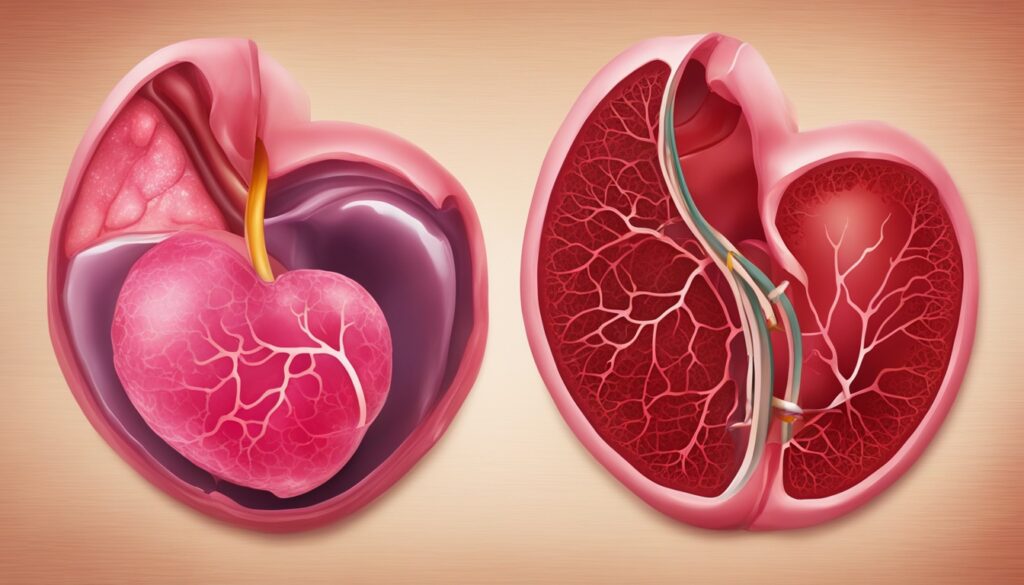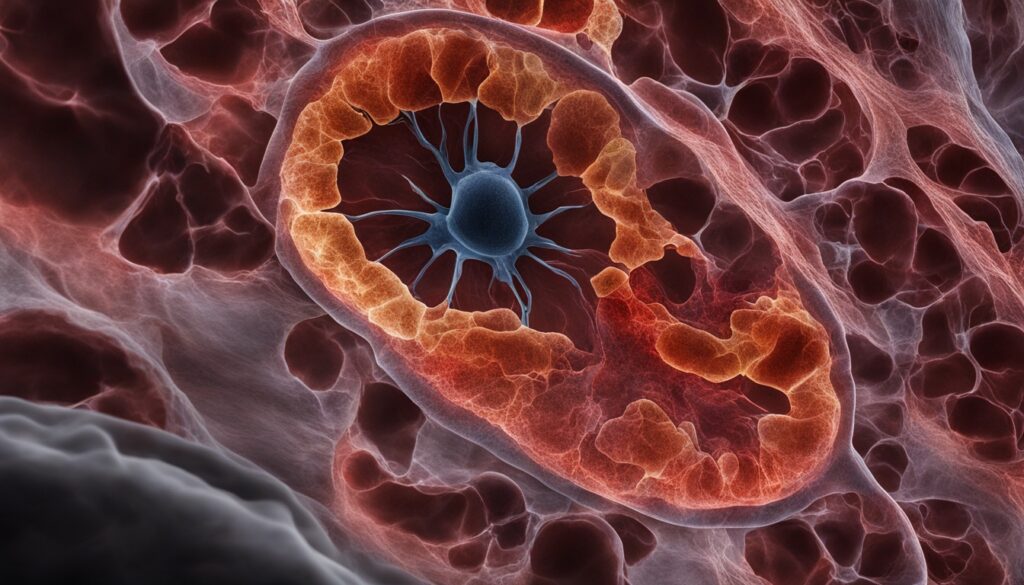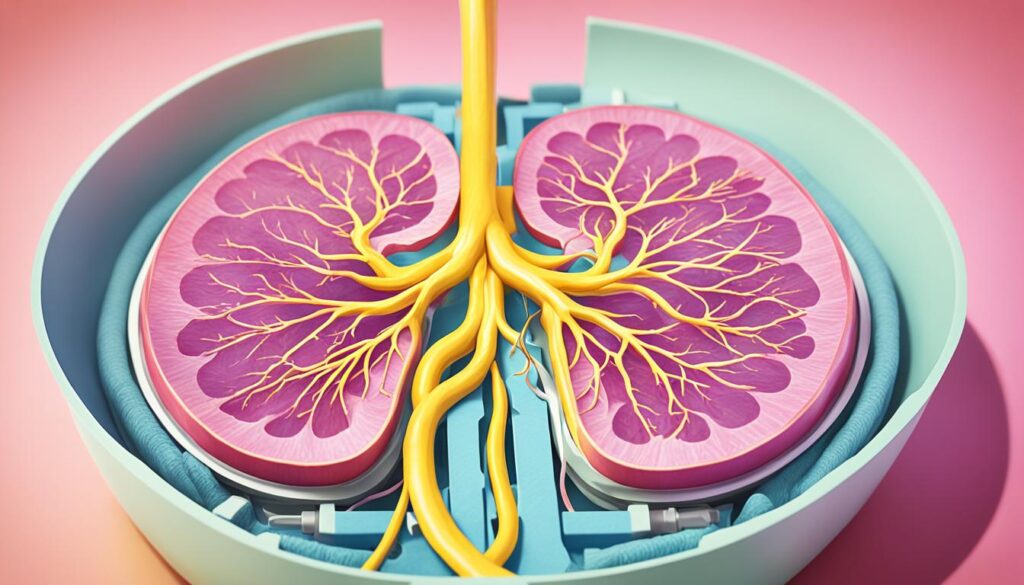In the United States, about 1 in 3 people with diabetes have diabetic nephropathy. This is a serious condition where high blood sugar damages the kidneys’ blood vessels. It makes it hard for the kidneys to filter waste and excess fluid from the body1. Diabetic nephropathy, or diabetic kidney disease, is common in both type 1 and type 2 diabetes1. Early treatment is crucial to stop or slow down this condition and lower the risk of kidney failure.

Key Takeaways
- Diabetic nephropathy affects about 1 in 3 people with diabetes in the US.
- Diabetes can damage the kidneys’ filtering units, leading to kidney failure.
- Risk factors include uncontrolled blood sugar, high blood pressure, and unhealthy lifestyle habits.
- Early detection and proper management of diabetes are crucial to preventing kidney disease.
- Regular check-ups and monitoring are essential for managing diabetic kidney disease.
Understanding Diabetic Kidney Disease
Definition and Overview
Diabetic kidney disease, also known as diabetic nephropathy, is a serious issue for people with diabetes. It’s when high blood sugar levels damage the kidneys’ blood vessels over time2. This damage can make it hard for the kidneys to filter waste and fluids from the blood, leading to harmful substances building up in the body.
How Kidneys Function Normally
The kidneys are key to our health, filtering waste, toxins, and extra fluids from the blood. They have millions of tiny blood vessel clusters called glomeruli that do the filtering. In healthy people, the kidneys work well, removing waste, balancing fluids, and keeping the right levels of minerals and nutrients.
But for those with diabetes, high blood sugar can damage these blood vessels. This makes the kidneys work less well3. This can lead to diabetic kidney disease, which can get worse if not treated.
“Diabetic kidney disease is a significant cause of sickness and death in people with diabetes and can lead to the need for dialysis or a kidney transplant.”3
Knowing the stages of diabetic kidney disease helps with early detection and management. By keeping an eye on kidney function and controlling blood sugar and blood pressure, people with diabetes can slow or stop this condition from getting worse3.
Signs of Kidney Failure Due to Diabetes
Early Signs and Symptoms
In the early stages of diabetic kidney disease, there might not be any symptoms4. But, as it gets worse, people may notice signs like high blood pressure that’s hard to control, swelling in the feet, ankles, hands, or eyes, and more4. These signs happen because the kidneys are getting damaged, causing waste to build up in the body.
Late Signs and Symptoms
When diabetic kidney disease gets worse, the kidneys might stop working, leading to a serious condition called end-stage kidney disease4. At this point, symptoms can be severe, including a big drop in urine output, severe swelling, and more5. People with this condition may need dialysis or a kidney transplant to survive5.
Finding kidney damage early in people with diabetes is key. It can slow down the disease and stop it from getting worse6. Regular tests, like urine tests for albumin and blood tests, can spot early signs of kidney disease5.

| Early Signs of Kidney Failure in Diabetes | Late Signs of Kidney Failure in Diabetes |
|---|---|
| High blood pressure Swelling in feet, ankles, hands, or eyes Foamy urine Confusion Shortness of breath Loss of appetite Nausea and vomiting Itching Tiredness | Significant decrease in urine output Severe swelling Nausea and vomiting Confusion Fatigue |
“Early detection of kidney damage in individuals with diabetes is crucial, as it can slow the progression of the disease and prevent the development of end-stage kidney failure.”
Causes and Risk Factors
Diabetic kidney disease, also known as diabetic nephropathy, is a serious issue for people with uncontrolled diabetes. It happens when high blood sugar levels damage the kidneys’ blood vessels and filtration units, called nephrons7. Over time, this damage can cause scarring and make the kidneys less able to filter waste and fluid from the body7.
How Diabetes Damages the Kidneys
Diabetes can harm the kidneys in several ways. High blood sugar makes the kidneys’ blood vessels thick and less efficient, affecting their waste filtering ability7. It can also cause small aneurysms in the kidneys’ blood vessels, which hurts their function7. This damage is the main cause of diabetic kidney disease7.
People at risk of getting diabetic kidney disease include those with uncontrolled high blood sugar, high blood pressure, smoking, high cholesterol, obesity, and a family history of diabetes and kidney disease789. Those with diabetes should see their doctor every three to six months for check-ups and to keep an eye on their blood sugar, blood pressure, and kidney health7.
| Risk Factors for Diabetic Kidney Disease |
|---|
| Uncontrolled high blood sugar |
| High blood pressure |
| Smoking |
| High cholesterol |
| Obesity |
| Family history of diabetes and kidney disease |
“Controlling blood sugar and blood pressure is crucial for preventing or slowing the progression of diabetic kidney disease.”
Complications of Diabetic Kidney Disease
Diabetic kidney disease, also known as diabetic nephropathy, can cause serious problems. It often leads to fluid buildup, causing swelling, high blood pressure, and fluid in the lungs10. This condition also raises the risk of heart disease, making stroke more likely10.
Sugar Defender – Blood Sugar Support
As the disease gets worse, kidneys may stop working right, needing dialysis or a transplant10. In 2011, about 26 million people in the U.S. had diabetes. Over 200,000 with diabetes-related kidney failure were on dialysis or had a transplant10.
Diabetic kidney disease can also make potassium levels in the blood too high, which is dangerous10. Type 1 diabetes is more likely to lead to severe kidney failure than type 2 diabetes. High blood pressure, a diabetes complication, also helps cause diabetic nephropathy11.
High blood pressure can speed up diabetic nephropathy’s progression to its final stage11. Catching kidney damage early is key. This can be done with urine tests for albumin, which shows diabetic nephropathy11.
| Complications of Diabetic Kidney Disease | Description |
|---|---|
| Fluid Buildup | Swelling, high blood pressure, and fluid in the lungs |
| Increased Cardiovascular Disease Risk | Elevated risk of stroke |
| Kidney Failure | Requiring dialysis or kidney transplant |
| Electrolyte Imbalances | Increased levels of potassium in the blood |

The effects of diabetic kidney disease are serious but can be managed early11. Treatment includes a healthy diet, exercise, checking blood sugar, taking medicine, and managing blood pressure10. ACE inhibitors and ARBs can slow down the disease’s progress11.
Sugar Defender – Blood Sugar Support
Diabetic kidney disease has big complications, but catching it early and managing it well can lessen its effects11.
Diagnosis and Monitoring
For people with diabetes, checking their kidney health is key. They face a higher risk of getting diabetic kidney disease12. It’s important to get tested every year if you have type 2 diabetes or have had type 1 diabetes for over five years12.
Tests and Screenings
Tests like the urinary albumin test and the albumin-to-creatinine ratio (ACR) help spot and track diabetic kidney disease12. The glomerular filtration rate (GFR) checks how well the kidneys filter blood12. Sometimes, X-rays, ultrasound, CT, and MRI scans are used to look at kidney health and blood flow12.
It usually takes a week to get the results of these tests13. This lets doctors make timely diagnoses and plan treatments13.
| Test | Purpose |
|---|---|
| Urinary Albumin Test | Detects the presence of albumin in the urine, which can indicate early kidney damage. |
| Albumin-to-Creatinine Ratio (ACR) | Measures the ratio of albumin to creatinine in the urine, providing a more accurate assessment of kidney function. |
| Glomerular Filtration Rate (GFR) | Evaluates how quickly the kidneys filter blood, helping to identify and monitor kidney disease. |
| Imaging Tests (X-rays, Ultrasound, CT, MRI) | Assess kidney health and blood flow within the kidneys. |
Spotting diabetic kidney disease early and keeping an eye on it is crucial for managing it well13. People with diabetes should team up with their doctors to get the right tests and care for their kidneys13.

Prevention and Management Strategies
People with diabetes face a higher risk of getting kidney disease14. High blood pressure is a big risk for kidney damage14. But, there are ways to prevent and manage diabetic kidney disease (DKD).
Controlling Blood Sugar and Blood Pressure
Keeping blood sugar and blood pressure under control is key to protecting the kidneys. This can be done with medicine, diet, and exercise14. It’s important to keep blood glucose and blood pressure at certain levels for diabetes management14. Taking medicines like ACE inhibitors and ARBs can also help protect the kidneys14.
Lifestyle Modifications
Changing your lifestyle can also help prevent or slow DKD. It’s recommended to eat less than 2,300 milligrams of sodium a day14 and less than 10% of daily calories from sugar14. The DASH eating plan can help lower blood pressure14. Try to get at least 30 minutes of exercise most days14, keep a healthy weight14, and sleep 7 to 8 hours a night14. Drinking less alcohol and doing stress-reducing activities like meditation and yoga are also good for your health14.
By using these strategies, people with diabetes can help protect their kidneys and lower the risk of DKD141516.

Treatment Options for Advanced Kidney Disease
Medications and Therapies
For those with advanced diabetic kidney disease, treatments include medications to control blood pressure and manage fluid and electrolyte imbalances17. If the kidneys are severely damaged, dialysis or a kidney transplant might be needed18.
Keeping blood pressure under control is key. ACE inhibitors and ARBs can help lower blood pressure and protect the kidneys19. Diuretics manage fluid buildup, and potassium-binding agents help control electrolyte levels.
When kidneys fail to the point of end-stage renal disease (ESRD), dialysis or a kidney transplant may be required. Dialysis uses a machine to filter waste and fluid from the blood, helping to manage kidney failure symptoms18. For some, a kidney transplant can restore function and improve life quality.

People with advanced diabetic kidney disease should work closely with their healthcare team. A personalized treatment plan might include medications, dietary changes, and possibly dialysis or transplantation, based on the disease’s severity171819.
Kidney Transplantation for Diabetic Patients
Kidney transplantation is a good option for people with end-stage kidney disease (ESKD) caused by diabetic kidney disease20. In 2020, about 39 percent of those waiting for a kidney transplant had ESKD from diabetes20. Also, around 33 percent of kidney transplant patients in the U.S. in 2020 had ESKD because of diabetes, making it the top reason for transplants20.
Sugar Defender – Blood Sugar Support
But, people with diabetes face special challenges before and after the transplant. They are more likely to have heart disease and get infections than those without diabetes20. Managing blood sugar after the transplant can be harder because of how insulin works differently, the effects of transplant medicines, and changes in how insulin acts in the body20.
For some with diabetes and ESKD, talking about a kidney-pancreas transplant might be an option20. This type of transplant could help fix both kidney failure and diabetes, leading to better long-term health.

Kidney transplantation can greatly improve life for people with diabetic kidney disease. But, it needs careful planning and managing diabetes to get the best results20. Deciding on a kidney transplant should be a team effort with doctors, considering the patient’s unique situation and health.
Pancreas Transplantation and Its Role
For people with diabetic kidney disease, a pancreas transplant can be key. It can stop the disease from getting worse and might even reduce the need for dialysis or another kidney transplant21.
About 15% of pancreas transplants go to people with type 2 diabetes21. The wait for a pancreas transplant is around 20 months. For a kidney and pancreas transplant together, it’s about 14 months21. Patients should stay healthy by taking their meds, eating right, exercising, keeping a healthy weight, and going to all their doctor’s appointments21.
Surgery for a pancreas transplant takes 3 to 6 hours. Risks include blood clots, bleeding, infections, and more21. Other risks are metabolic problems, urinary issues, pancreas failure, rejection, and side effects from anti-rejection drugs21.
People with type 1 diabetes that can’t be controlled might consider a pancreas transplant. This is also true for those with frequent insulin reactions, poor blood sugar control, severe kidney damage, or type 2 diabetes with low insulin levels21. There are different types of pancreas transplants, like transplanting just the pancreas or combining it with a kidney transplant21.
Successful pancreas transplants have many benefits. By June 2019, over 19,000 recipients had a working pancreas graft22. Survival rates after five years were high for different types of transplants22. This surgery can also improve blood sugar levels and quality of life22.

In summary, a pancreas transplant can be a big help for those with diabetic kidney disease. It offers a chance to manage the disease better and improve health2122.
Conclusion
Diabetic kidney disease is a serious issue for many Americans with diabetes23. It affects over 34 million people in the U.S., making up 10.5% of the population23. It’s important to catch it early and manage both diabetes and kidney health to stop it from getting worse24.
Sugar Defender – Blood Sugar Support
Good care, like keeping blood sugar and blood pressure in check, making lifestyle changes, and using new medicines, can help23. These steps can protect kidney function and overall health. By focusing on the main causes of diabetic kidney disease, people can take steps to keep their kidneys healthy and improve their life quality24.
Dealing with diabetic kidney disease is tough, but the right care can help. By being careful, seeing doctors regularly, and using proven methods, people with diabetes can fight kidney failure and keep their health up2324.
FAQ
What is diabetic kidney disease?
Diabetic kidney disease, also known as diabetic nephropathy, is a serious issue for people with type 1 and type 2 diabetes. It happens when high blood sugar damages the kidneys’ blood vessels. This makes it hard for the kidneys to filter waste and excess fluid.
How common is diabetic kidney disease in the United States?
In the United States, about 1 in 3 people with diabetes have diabetic nephropathy.
What are the early signs and symptoms of diabetic kidney disease?
Early on, diabetic kidney disease might not show any symptoms. Later, you might notice high blood pressure that’s hard to control, swelling in the feet, ankles, hands, or eyes, and more. Other signs include foamy urine, confusion, shortness of breath, loss of appetite, nausea and vomiting, itching, and feeling very tired.
What are the late signs and symptoms of diabetic kidney disease?
Later, the kidneys may stop working altogether. This can lead to a serious condition called end-stage kidney disease.
How does diabetes damage the kidneys?
High blood sugar levels damage the kidneys’ blood vessels and filtering units, called nephrons. Over time, this can cause scarring and reduce the kidneys’ ability to filter waste and excess fluid.
What are the risk factors for developing diabetic kidney disease?
Risk factors include high blood sugar, high blood pressure, smoking, high cholesterol, obesity, and a family history of diabetes and kidney disease.
How is diabetic kidney disease diagnosed?
Doctors use tests like blood and urine samples to diagnose diabetic kidney disease. These tests check for proteins in the urine that suggest kidney damage.
How can diabetic kidney disease be prevented or delayed?
To prevent or slow diabetic kidney disease, keep blood sugar and blood pressure under control. Use medication, eat right, and exercise. Also, maintain a healthy weight, quit smoking, and eat less salt to protect your kidneys.
What are the treatment options for advanced diabetic kidney disease?
For advanced disease, treatments include blood pressure and fluid management medications. In severe cases, dialysis or a kidney transplant might be needed if the kidneys can’t work well anymore.
Can a kidney transplant be a viable option for diabetic patients with end-stage kidney disease?
Yes, a kidney transplant can be an option for those with end-stage kidney disease from diabetes. It’s important to carefully evaluate and manage diabetes for the best outcomes.
Can a pancreas transplant play a role in the treatment of diabetic kidney disease?
A pancreas transplant can also be considered for diabetic kidney disease. It can address the diabetes cause, potentially stopping disease progression and reducing dialysis or kidney transplant needs.
Sugar Defender – Blood Sugar Support
Source Links
- Diabetic nephropathy (kidney disease) – Symptoms and causes – https://www.mayoclinic.org/diseases-conditions/diabetic-nephropathy/symptoms-causes/syc-20354556
- Diabetes and kidney disease – https://www.mountsinai.org/health-library/diseases-conditions/diabetes-and-kidney-disease
- What Is Diabetic Nephropathy? – https://www.webmd.com/diabetes/diabetes-kidney-disease
- Diabetic kidney disease – https://patient.info/diabetes/diabetes-mellitus-leaflet/diabetic-kidney-disease
- Diabetes and kidney disease – UF Health – https://ufhealth.org/conditions-and-treatments/diabetes-and-kidney-disease
- Diabetes – https://www.kidneyfund.org/all-about-kidneys/risk-factors/diabetes
- Diabetes-Related Nephropathy: Causes, Symptoms & Treatment – https://my.clevelandclinic.org/health/diseases/24183-diabetic-nephropathy
- Chronic kidney disease – Symptoms and causes – https://www.mayoclinic.org/diseases-conditions/chronic-kidney-disease/symptoms-causes/syc-20354521
- Diabetes and Chronic Kidney Disease – https://www.kidney.org/news/newsroom/factsheets/Diabetes-And-CKD
- Diabetic Nephropathy (Kidney Disease) – https://www.hopkinsmedicine.org/health/conditions-and-diseases/diabetes/diabetic-nephropathy-kidney-disease
- Diabetic Nephropathy – StatPearls – NCBI Bookshelf – https://www.ncbi.nlm.nih.gov/books/NBK534200/
- Diabetic nephropathy (kidney disease) – Diagnosis and treatment – Mayo Clinic – https://www.mayoclinic.org/diseases-conditions/diabetic-nephropathy/diagnosis-treatment/drc-20354562
- Diabetic nephropathy (kidney disease) – https://www.diabetes.org.uk/guide-to-diabetes/complications/kidneys_nephropathy
- Preventing Chronic Kidney Disease – NIDDK – https://www.niddk.nih.gov/health-information/kidney-disease/chronic-kidney-disease-ckd/prevention
- Diabetic Kidney Disease: Diagnosis, Treatment, and Prevention – https://www.aafp.org/pubs/afp/issues/2019/0615/p751.html
- Preventing Chronic Kidney Disease – https://www.cdc.gov/kidney-disease/prevention/index.html
- Management of Kidney Failure in Patients with Diabetes Mellitus: What Are the Best Options? – https://www.ncbi.nlm.nih.gov/pmc/articles/PMC8268456/
- Treatment of diabetic kidney disease – https://www.uptodate.com/contents/treatment-of-diabetic-kidney-disease
- Kidney Disease – https://www.webmd.com/a-to-z-guides/understanding-kidney-disease-basic-information
- Kidney transplantation in diabetic kidney disease – https://www.uptodate.com/contents/kidney-transplantation-in-diabetic-kidney-disease
- Pancreas transplant – Mayo Clinic – https://www.mayoclinic.org/tests-procedures/pancreas-transplant/about/pac-20384783
- Pancreas Transplantation: Practice Essentials, Background, Pathophysiology – https://emedicine.medscape.com/article/429408-overview
- The connection between diabetes, kidney disease and high blood pressure – https://www.heart.org/en/news/2020/11/03/the-connection-between-diabetes-kidney-disease-and-high-blood-pressure
- Diabetic Nephropathy – an overview – https://www.sciencedirect.com/topics/medicine-and-dentistry/diabetic-nephropathy